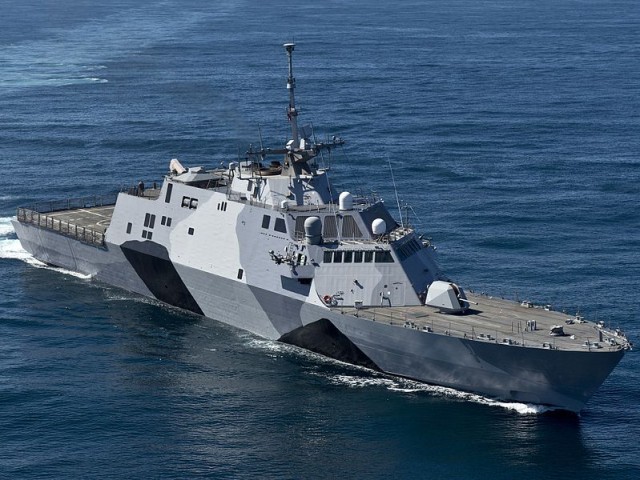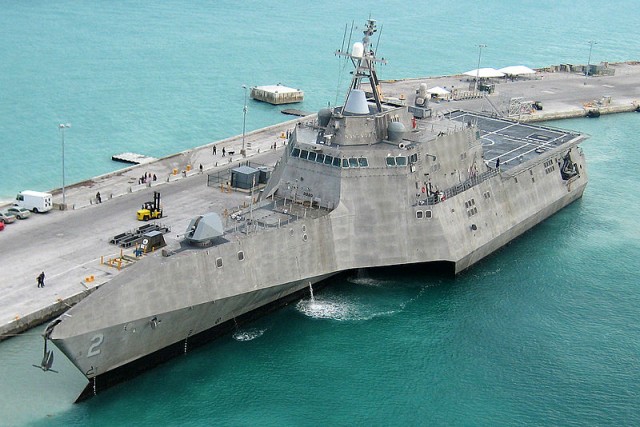Littoral failure: Navy hedges bets on high-tech littoral combat ships
DoD looks for alternatives to modular ship that are less likely to be cannon fodder.

The USS Freedom (LCS-1), one of three
littoral combat ships now in service, is designed for fighting the last
war—but probably not the next.
US Navy
But there could still be good news for the defense contractors building the LCS: the options include a beefed-up version of the ship that could raise its cost further—and increase the profits of Lockheed Martin and Austal USA in the process. Considering the fact that these ships have already had significant problems (including “aggressive corrosion“ of one design’s hull because it didn’t include cathodic protection), yet another design change could cost the US billions more for a class of ships that has never lived up to its concept.
Stu Slade, warship analyst for Forecast International, told National Defense, “This isn’t a done deal. It’s certainly a setback for the LCS program viewed in isolation, but it’s one that could yet be reversed” because the cuts won’t hit until 2016—when the White House gets a new occupant.
Back to the future
In a way, the LCS is a hangover from the Army’s Future Combat Systems program. The Navy intended the LCS to be an all-in-one replacement for its aging guided missile frigates and minesweepers, taking on both anti-mine and anti-submarine roles. But the Navy also wanted to use the ship to provide fire support for troops ashore, using technology being developed by the Army for its force modernization: the Fire Scout unmanned helicopter and the Non-Line Of Sight (NLOS) Missile system.To accommodate all of these roles, the Navy pushed for a ship design that would ideally allow the LCS to change jobs by swapping out modules. Additional modules, such as anti-surface ship systems and “irregular warfare” packages to support special operations troops, could be built separately to avoid the need to build other specialized ships, saving money. And all of this was bundled together with technology to reduce the required crew size for the LCS.
The NLOS was supposed to give the LCS serious firepower, with a range of 25 miles and the ability to hit targets on land and sea. The modular missile system was supposed to provide two capabilities: a “precision attack munition” (PAM) using inertial and GPS guidance, with infrared and laser designation by the Fire Scout or a ground spotter, and a “loitering attack munition” (LAM) that could fly to a designated point and wait for a target of opportunity.
But the NLOS has never materialized, mostly because of the collapse of the Army’s Future Combat Systems project. Another system, the Griffin missile, is still being considered as an alternative. The Griffin, which only has a range of 3.5 miles, was designed for use on aircraft against ground targets and would only be effective against “swarm” small boat attacks.
The mission modules themselves also turned out to be something of a bust. After evaluations, it was determined that it would take weeks, not days, to swap out an LCS’ mission modules, and the process would be much more expensive than anticipated. So the Navy decided that those “modules” would be more or less permanent instead, fixing the role of the ships they were deployed on outside of a major overhaul.
In the end, what the Navy got was a ship that was suited to none of these jobs in particular, designed to operate in what Defense Secretary Chuck Hagel recently described as “permissive environments.” In other words, it was designed for wars like the Iraq War, where there was no need to worry about threats from aircraft, ships, or coastal missile batteries. And by ordering 52 of them, the Navy was effectively guaranteeing that a sixth of its fleet would be made up of sitting ducks for those sorts of attacks.
The cost overruns of the LCS program haven’t helped its case much. The Navy ended up picking two winners for the program: Lockheed Martin’s more traditional Freedom class design and the General Dynamics/Austal USA trimaran Independence class. (Full disclosure: the Lockheed Martin program was run by my former commanding officer aboard USS Iowa, Fred Moosally.) Cost overruns caused the Navy to hold up building more ships several times. Only three LCS ships have been delivered so far; a fourth, the Milwaukee, was launched in December, and another 20 are already on order. So the Navy’s “freeze” actually allows the Navy to order 12 more ships before 2016, down from the 28 planned.

Enlarge / The Austal USA-built trimaran USS Independence.
US Navy
The Milwaukee is launched on December 18, 2013.
Back to the drawing board (sort of)
This month, Chief of Naval Operations Adm. Jonathan Greenert created a task force to look into alternatives to the LCS that would be more effective against air attacks, submarines, and surface vessels. The Small Surface Combatant Task Force, which is led by Marine Corps Systems Command Director John D. Burrow, has until July to come up with the best option.Given the constraints that the task force is under, the answer may turn out to be a bigger, badder version of the LCS, because anything else would require a totally new design process or a switch to another existing design. The Navy could conceivably go with a modified version of the Coast Guard’s National Security Cutter as an option, or it could buy a new multi-mission frigate being built for the French and Italian navies. But both of those options seem highly unlikely since the designs come from outside the Navy’s development process.
The most likely outcome of this trip back to the drawing board, then, is a bigger, heavier version of the LCS, with a bigger crew and more weapons systems. In other words, it will be a lot more expensive, and it will give the companies that built the LCS in the first place a chance to squeeze more money out of what has been a questionable effort from the start.



No comments:
Post a Comment